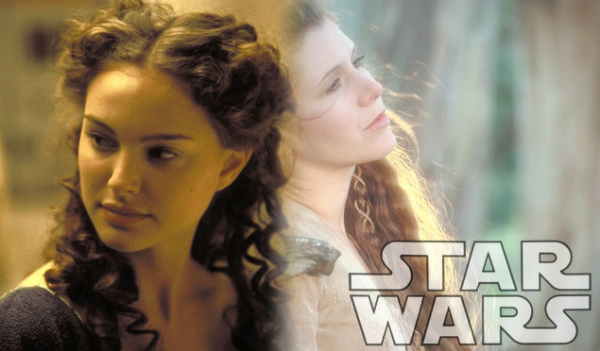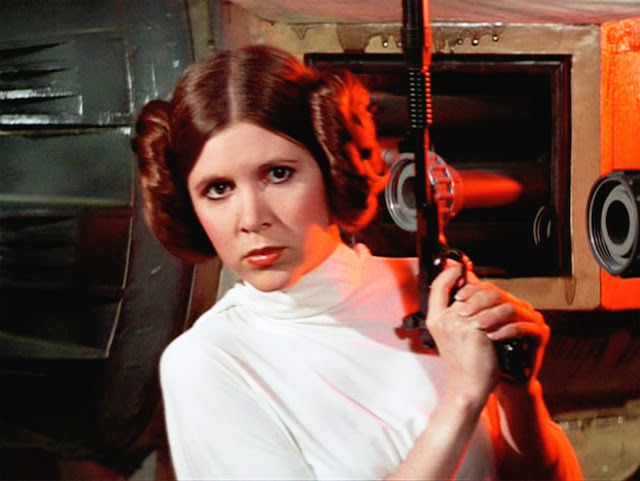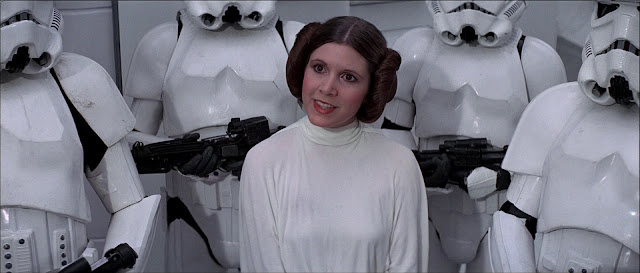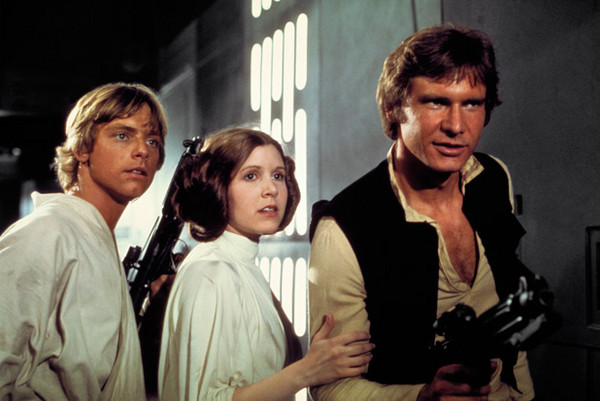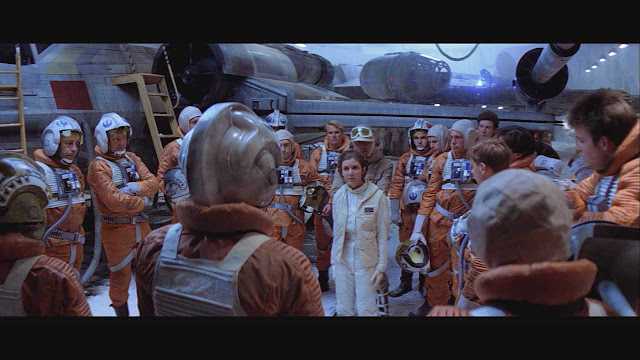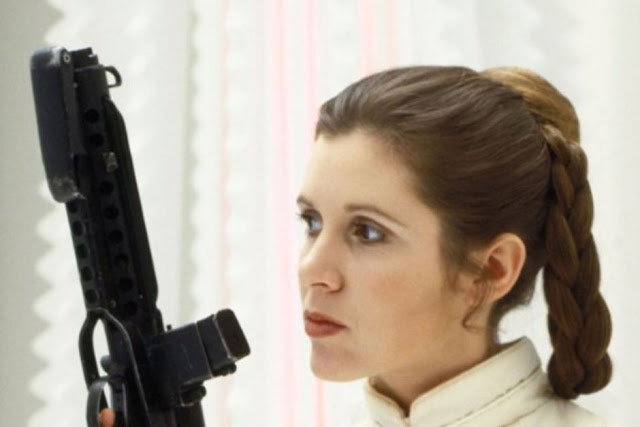
Written by Amanda Rodriguez.
As buzz builds around the upcoming and presumably final Star Wars trilogy following the announcement of the Episode VII’s cast, I’m relieved to see that, with the recent addition of Game of Thrones‘ Gwendoline Christie and 12 Years a Slave‘s Lupita Nyong’o, the Star Wars franchise is trying to overcome its reputation as a sausage-fest. With Daisy Ridley on board (I’m guessing to play Han and Leia’s daughter) and veteran Carrie Fisher, who’ll be reprising her role as the iconic Princess Leia, these women quadruple the number of female leads that typically appear in a Star Wars trilogy. That’s right. Until now, space has apparently been no place for women, especially strong women with more than one or two lines. Now we just have to hope that Christie and Nyong’o won’t be used as Othered alien cameos and that these women’s considerable talents will be used, instead, to enrich the flagging franchise.
Consider the way the questionable way George Lucas has dealt with the very few women of Star Wars from the beginning. For the original Episodes IV-VI, we have Fisher as the tough rebel leader, but still royalty, Leia Organa…the only female character of note in the entire trilogy.

In the prequel Episodes I-III, we have Natalie Portman playing Padmé Amidala, Luke and Leia’s mother as well as a strong, independent, politically savvy queen…the only female character of note in the follow-up trilogy.

Basically, despite the fact that entire Star Wars trilogies feature only a single female lead, each trilogy starts off with promise because that lone lady happens to be an empowered women who leads others with compassion, but isn’t afraid to get her hands dirty by firing a few blasters.

Though Leia is the apex of yet another insipid (and incestuous) cinematic love triangle, her role as a critical leader in the rebellion is far more defining of her identity. In A New Hope, Leia is captured by Imperial forces and tortured. Not only does she not reveal the location of the rebel alliance, she is also integral in the success of her own rescue at the hands of Han and Luke. She also displays remarkable bravery, intelligence, and an innate talent for The Force (shown in both Empire Strikes Back and Return of the Jedi through unexplained knowledge, strength, and a supernatural connection to her twin, Luke).

Interestingly enough, one of Leia’s most seriously badass scenes is also, conversely, her most iconically objectifying one as well. When Leia poses as a “ruthless” bounty hunter to infiltrate Jabba’s Palace to rescue Han in Return of the Jedi, her cool points went through the roof. I love the idea of the woman organizing a team to go in and rescue her male love interest. However, women being in love within the Star Wars universe never goes well, and Leia is captured and forced to don scanty clothing and lounge beside Jabba. The film is vague about whether or not she has been raped or forced to engage in sexual acts with Jabba, but from here on out, Leia’s image as “Slave Leia” has gone down in pop culture as well as sexual fetish history and continues to be a popular cosplay for nerd gals and others.

Though Leia is demeaned, harassed, threatened, and disgusted by her captor, in the end, she’s able to take charge. With nothing but the chain around her neck, enslaving her, she kills Jabba, one of the most iconic villains of all time before aiding the rest of her friends in their escape. Her self-liberation, that she’s integral to her team and their escape, and that she fucking killed Jabba the fucking Hut goes a long way to distract us from the fact that for two films, we didn’t even see Leia’s wrists or ankles and suddenly, now that she’s in love, she’s a prime target for grossly sexualized objectification.

Later in Return of the Jedi, things get even dicier for Leia when she’s befriended and essentially held hostage by the furry Ewoks (I wonder if Lucas has some sexual fetishes he was indulging in this film). They give her a rustic dress, braid her hair and make her wear it down for the first time in the trilogy. They protect her and ignore her. Essentially, the Ewoks relegate Leia to a traditional female role, removing her agency. Leia is rescued by her friends yet again. The fact of the matter is that Leia, our only female character, is captured and rescued more than any other character in the trilogy. In the end, the film gives her back a measure of agency, and she is allowed to fight in the final battle.
Leia’s mother, Padmé, is a more extreme example of Lucas’ at best confused, at worst fucked-up attitude toward women in that her highs are higher, but her lows are so very, very much lower. On the positive side, Padmé is a popular and well-respected ruler-turned-Senator who is courageous in her dedication to her people. She generally wields her power for good, in defense of her planet and is never power hungry, nor is she a mere figurehead (despite the ridiculous ornamental nature of her wardrobe). She is alternately a diplomat and a warrior when the need arises.

Though considerable, that’s where Padmé’s awesomeness ends. Throughout all three films, she is treated like a doll with her parade of outfits and her elaborate face painting. There’s even a Star Wars wiki page dedicated to her extensive wardrobe. Much of her Naboo state attire is even offensive with its appropriation of Asian cultural aesthetic.

Despite the focus the films place on her body via her endless stream of costumes, Padmé mostly remains a badass (except for her vote of no confidence in Chancellor Valorum that opens the door for Palpatine to take control of the Senate, ushering in the tyranny of the Empire for decades to come…except for that). All agency slips from her, though, when Padmé falls in love with the atrociously acted Anakin Skywalker.

Her story ceases to be one about political advocacy, diplomacy, and her struggles to keep her people’s liberties and safety intact. Instead, Padmé becomes little more than a love interest and a pretty face. Ignoring the fact that the love story is painfully trite and stilted with zero chemistry and wooden acting, this romance becomes all that Padmé is about. She marries Anakin in secret and becomes pregnant, and her personality totally changes. She becomes a simpering, deplorable character who dies of a broken heart. I mean, who cares that Anakin has been a childish wanker from the beginning and that she’s got a newborn set of twins? Life, I guess, is just too unbearable for a once strong and independent woman once she realizes she made a bad choice in love.
[youtube_sc url=”https://www.youtube.com/watch?v=tfX01lURXFk”]
Interestingly enough, Lucas did a better job in the 70s and 80s with his depiction of Leia than he did 20 years later when he brought Padmé to life.

It’s a sad state of affairs when representations of women become progressively less feminist as time goes on. Despite the fact that certain parties are involved: Lucas with his growing record of bad judgment and J.J. Abrams with his habit of taking all the substance out of sci-fi franchises, I can’t help but be hopeful that the new Star Wars trilogy will get it right where its predecessors failed. Though the series has let me down before (Episodes I-III were, frankly, Bantha fodder), having several actresses on the cast for this new trilogy, women known for their strong female characters is a bright spot in a franchise that’s rapidly turning towards the Dark Side.
Of George Lucas, I, like Luke, can only say, “There is good in him. I’ve felt it.” And I, like Luke, will continue to have faith until it is perhaps too late.
Read also: Women in Science Fiction Week: Princess Leia: Feminist Icon or Sexist Trope?
Bitch Flicks writer and editor Amanda Rodriguez is an environmental activist living in Asheville, North Carolina. She holds a BA from Antioch College in Yellow Springs, Ohio and an MFA in fiction writing from Queens University in Charlotte, NC. She writes all about food and drinking games on her blog Booze and Baking. Fun fact: while living in Kyoto, Japan, her house was attacked by monkeys.
